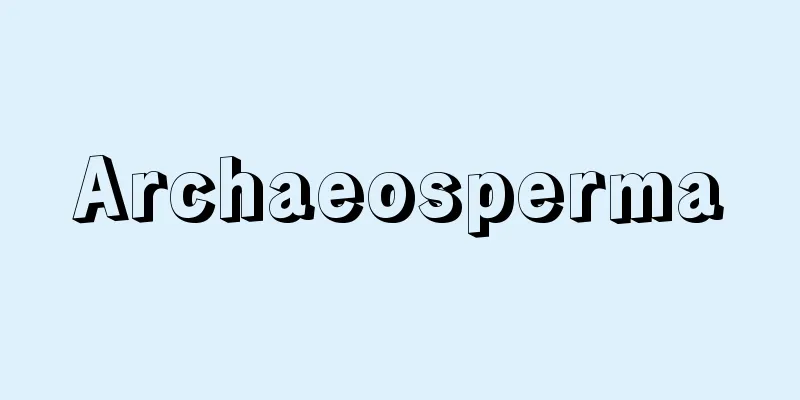Serow - Kamoshika (English spelling)

|
A general term for animals in the genus Capricornis, family Bovidae, order Artiodactyla, class Mammalia. In Japan, the word antelope is pronounced as kamo shika, but antelope refers to an antelope found in Africa. On the other hand, the original name of antelope is serow, but in Japan, the two are often confused, so it is important to distinguish them clearly. The genus Capricornis is closely related to the goral, chamois, and mountain goat, and is found in the Himalayas, Kashmir, southern China, Myanmar (Burma), the Malay Peninsula, Taiwan, and Japan. There are three species: the Japanese serow C. crispus , the Taiwanese serow C. swinhoei , and the maned serow C. sumatraensis . [Masanobu Kitahara] formThe body is sturdy, and the sexes are almost the same size. Both sexes have black horns, which stand vertically with the tip of the skull facing down, and when viewed from the front, extend upwards along the same plane as the face, but curve gently backwards toward the tip. They are cylindrical in shape, thick at the base, and have many distinct ring-shaped protuberances. The nasal speculum is exposed, and there are well-developed parotid glands under the eyes and interhoof glands between the hooves. The hooves are wide and suitable for living in rocky areas. In Japan, the Japanese serow is distributed in the mountainous regions of Honshu, Shikoku, and Kyushu. The head and body length is 100 to 120 cm, shoulder height is 68 to 72 cm, and weight is about 20 kg. The ears and tail are short. The fur is long and woolly, measuring 10 cm, and grows densely. Most individuals have a dark brown body color, but there is a wide variation from black to white even within the same habitat, and the color also varies depending on the region, but generally the warmer the region the darker the color. There is no mane-like long hair on the neck. The Formosan serow, endemic to Taiwan, lives in the mountainous regions of Taiwan. With a head and body length of 70-80 cm and shoulder height of 50-60 cm, it is slightly smaller than the Japanese serow. It has short fur, reddish brown chin and throat, and white spots on the chest and belly. Its limbs are chestnut brown with black lines on the front. It has long ears. The maned serow (English name: maned serow), also known as the Sumatran serow, is distributed from Sumatra north to the Himalayas and the lowlands of southern China, and there are many subspecies. It is larger than the Japanese serow, with a head and body length of 130-180 cm, shoulder height of 97-105 cm, and weight of around 70 kg, and has thin, coarse fur. It has a long mane from the neck to the back and long ears. Its body color varies widely from gray-black to reddish brown. [Masanobu Kitahara] EcologyJapanese serows establish fixed territories mainly in rocky mountainous areas, do not have specific nests, and sleep on rocks. When chased by enemies, they flee to rugged places where enemies cannot approach. They are not afraid of humans and have a gentle nature. They mate from mid-October to November, and usually give birth to one baby in April to June of the following year. The baby walks immediately after birth and stays with its mother for about a year. They are often found at altitudes of 1,200 to 1,500 meters in the Northern Alps, but the habitat becomes lower as they move north, and they can also be found on the coastline of the Shimokita Peninsula in Aomori Prefecture. There are always deciduous and coniferous trees in this habitat, and they live in areas where they intertwine to form forests, and they use these forests to live. During the snowy season, they feed on the ridges of deciduous trees, where avalanches do not occur, and eat twigs and winter buds of deciduous trees, and during the snowless season, they feed on the streams where there are many soft herbaceous plants. Coniferous trees grow in rocky areas and steep terrain, so they use these forests as roosts and resting places all year round. Their daily routine is simple, leaving their roosts early in the morning, foraging while they reach a spot with good visibility and low predator access at around 10am, where they spend time ruminating during the day. They forage again in the afternoon, and return to their roost in the evening. They also move around a little around their roosts at night. During these movements, they sharpen their horns on standing trees about 5 centimeters in diameter, and mark the tips of twigs they have eaten by rubbing their parotid glands on the tips of twigs about 5 millimeters in diameter. The maned serow has a wide distribution and lives in canyons at altitudes of 3,000 to 4,000 meters, where they eat twigs and leaves from humid forests and bamboo groves. In the tropical island of Sumatra, they live in hilly areas, which always have steep rocky areas, water sources, forests, etc. The Formosan serow also lives in a similar environment, but is found at altitudes from the foot of the mountains to 3,500 meters above sea level. The Japanese serow is also called Aoshishi, Kurashishi, Niku, etc., and it seems that it used to be common in mountainous areas. However, it was hunted excessively for its fur and its horns, which were suitable for making lures for bonito fishing, and its population once dropped sharply. However, since February 1955, when it was designated as a special natural monument and protected as a species endemic to Japan, its population has started to increase. Until recently, there was no trace of the Japanese serow in Shikoku, and it was thought to be extinct, but in recent years, they have been spotted in the mountains, and it has been discovered that they still exist, albeit in small numbers. In Honshu, damage caused by the Japanese serow to planted trees became noticeable after 1965, and in 1980, Osaka Town in Gifu Prefecture (now Osaka Town in Gero City), as well as forestry prefectures in Nagano, Aomori, and Iwate, came up with measures to capture them using tranquilizer guns. However, Japanese serows are a so-called geographical relic species that live in a stepping-stone distribution range, and can be considered living fossils. Because they are suited to the special high mountain environment, they are thought to be unable to adapt to sudden environmental changes, and immediate countermeasures are therefore needed. [Masanobu Kitahara] FolkloreThe Japanese serow is an important type of hunting animal in Japan, and in many regions it is called "niku" or "shishi" because it is a meat-eating animal. In the entry for the second year of the reign of Empress Kogyoku in the "Nihon Shoki," there is a poem likening the appearance of a serow passing through rocky mountain areas to an old man, "The old man of the kamashishi, who stood up and passed by," and it is said that the serow can stand on rocky areas that even bears and dogs cannot reach, so their hooves stick to the rocks. In documents from the Edo period, such as the "Honcho Shokkan," it is also said that the serow can stand on cliff rocks and rest without putting its feet on the ground by resting its horns on tree branches. In Akita Prefecture, the hunters, called Mata-gi, held a careful serow hunting ceremony. The ceremony included a memorial service in which the skin was removed, and the innards were skewered and offered to the mountain god. In some villages, it was more respectful than in the case of bears. Its meat is generally highly valued, and in Nagano Prefecture, meat from when the leaves have fallen is called "leaf meat" because it has the scent of wood, and it is said that eating it warms the body and helps children wet their beds. In Akita Prefecture, the small intestine is considered a delicacy, and it is said that drying it will help with stomach aches, and dissolving it and applying it to swelling will quickly cure them. The amber-colored horns found in about one in every ten katsuobushi were used as bait lures for bonito fishing, and were sold at a high price. It was also said that if a female carried twins in her belly, they would always have a pearl inside, and some families passed down a ball about 6 minutes (about 1.82 centimeters) in diameter, called a kamoshika's pearl, as a talisman. [Yo Kojima] [References] | | | | |©Kimura Shuji "> Main species of Japanese serow (specimen drawing) Distributed in Honshu, Shikoku, and Kyushu. Generally lives in mountainous areas at an altitude of 1000-2000m. Both males and females have horns, which are 8-15cm long. A species endemic to Japan, it is also called Aoshishi, Kura-shishi, Kamoshishi, and Niku. Head and body length is 100-120cm, shoulder height is 68-72cm, and weight is about 20kg. Nationally designated special natural monument ©Shogakukan "> Japanese serow Source: Shogakukan Encyclopedia Nipponica About Encyclopedia Nipponica Information | Legend |
|
哺乳(ほにゅう)綱偶蹄(ぐうてい)目ウシ科カモシカ属に含まれる動物の総称。日本では羚羊と書いてもカモシカと読ませているが、羚羊はアフリカなどにいるレイヨウ、英名アンテロープantelopeをさす。一方、本来のカモシカは英名をシーローserowというが、日本ではしばしばこの両者を混同しているのではっきり区別したい。カモシカ属Capricornisはゴーラル、シャモア、シロイワヤギなどに近縁で、ヒマラヤからカシミール、中国南部、ミャンマー(ビルマ)、マレー半島および台湾、日本に分布し、ニホンカモシカC. crispus、タイワンカモシカC. swinhoei、タテガミカモシカC. sumatraensisの3種がある。 [北原正宣] 形態体は頑丈で雌雄ほぼ同大。角(つの)は黒く雌雄にあり、頭骨の先端を下にして顔面を垂直に立て、正面よりみると顔とほぼ同じ面を上に伸びるが、先端に進むにつれて後方に緩く曲がる。形は円筒形で、基部は太く多数の明瞭(めいりょう)な輪状の隆起がある。鼻鏡は露出し、目の下によく発達した眼下腺(がんかせん)と、ひづめの間に蹄間腺(ていかんせん)がある。ひづめは幅広く岩場の生活に適する。日本にはニホンカモシカが本州、四国、九州の山岳地帯に分布する。頭胴長100~120センチメートル、肩高68~72センチメートル、体重約20キログラム、耳と尾は短い。被毛は10センチメートルと長く羊毛状で密生する。体色は暗褐色の個体が多いが、黒色から白色まで同一産地でも変異が多く、また地方により色が異なるが、一般に温暖な地方のものほど暗色である。頸(くび)にたてがみ状の長毛はない。台湾特産のタイワンカモシカは台湾の山岳地帯に生息する。頭胴長70~80センチメートル、肩高50~60センチメートルで、ニホンカモシカよりやや小形である。被毛は短くあごとのどが赤褐色、胸と腹に白斑(はくはん)がある。四肢は栗(くり)色で前面に黒線がある。耳は長い。タテガミカモシカ(英名maned serow)、別名スマトラカモシカはスマトラ島から北はヒマラヤ、中国南部の低地にかけて分布し、多くの亜種がある。頭胴長130~180センチメートル、肩高97~105センチメートル、体重70キログラム前後でニホンカモシカより大きく、被毛が薄くて粗い。頸から背にかけて長いたてがみがあり、耳は長い。体色は灰黒色から赤褐色まで変異が多い。 [北原正宣] 生態ニホンカモシカは岩場の多い山岳地帯を中心に一定の縄張りをつくり、特定の巣はもたず、岩場などで眠る。敵に追われると、それらが近づけない険しい場所に逃げ込む。人を恐れず性質は温和である。交尾期は10月中旬から11月ごろ、翌年4~6月に普通1子を産む。子は生後すぐに歩き、母親と約1年いっしょにいる。北アルプスでは標高1200~1500メートルに多くみられるが、北上するにつれ生息域が低くなり、青森県下北(しもきた)半島では海岸線にも生息する。この生息地域内にはかならず落葉樹と針葉樹があり、それらが入り組んで森林を構成する所で、その森林を使い分けて生活する。積雪期には雪崩(なだれ)のおこらない落葉樹の尾根筋を採食場として落葉樹の小枝や冬芽を食べ、無雪期には柔らかな草本類が多い沢筋を採食場とする。針葉樹は岩場や急峻(きゅうしゅん)な地形に多く生育するため、それらの林をねぐらや休息場として一年中使用する。1日の行動は単純で、早朝ねぐらより出て、採食しながら10時ごろ見晴らしがよく敵が近づきにくい地点に至り、そこで時間をかけて日中の反芻(はんすう)を行う。午後はふたたび採食に入り、夕方ねぐら場に至る。夜間もねぐら周辺で多少行動する。これらの行動中に、直径5センチメートルぐらいの立ち木で角(つの)研ぎを、また食べたあとの小枝の先、直径5ミリメートル前後のところに眼下腺をこすり付けマーキングをする。広い分布域をもつタテガミカモシカは標高3000~4000メートルの峡谷にすみ、湿度の高い森林や竹やぶの小枝や葉を食べる。熱帯のスマトラ島では丘陵地帯にすむが、そこには険しい岩場や水場、森林などがかならずある。タイワンカモシカも同様な環境にすむが、山麓(さんろく)から標高3500メートルにみられる。 ニホンカモシカはアオシシ、クラシシ、ニクなどとよばれ、かつては山地に普通にいたことがうかがわれる。しかし毛皮とカツオ漁業用の擬餌鉤(ぎじばり)に適した角のため乱獲され、一時生息数が激減した。しかし1955年(昭和30)2月に日本特産種として特別天然記念物に指定保護されて以来増加し始めた。四国では従来カモシカの手掛りがなく、すでに絶滅したものといわれていたが、近年になって山中でその姿が確認され、少数ではあるが生息が判明した。本州では1965年以後ニホンカモシカによる植林木に対する食害が目だち始め、1980年岐阜県小坂(おさか)町(現下呂(げろ)市小坂町)をはじめとし、長野、青森、岩手の林業県が麻酔銃による捕獲対策を打ち出した。しかしカモシカは飛び石的分布域に生息するいわゆる地理的な遺存種(レリック)で、生きた化石的動物といえ、高山という特殊な環境に適しているため、急激な環境変化には対応できないと思われるので、早急な対応策が必要である。 [北原正宣] 民俗カモシカは日本の重要な狩猟獣の一種で、肉を食べる獣の意味から、ニクあるいはシシとよぶ地方が多い。『日本書紀』皇極天皇(こうぎょくてんのう)2年の条に、「たげて通らせ氈鹿(かましし)の老翁(おじ)」と、山の岩場を通るカモシカの姿を老人に例えた歌がみえているが、カモシカはクマやイヌも行けないような岩場にも立つため、ひづめが岩に吸い付くといわれる。『本朝食鑑(ほんちょうしょっかん)』など江戸時代の文献には、カモシカは断崖の岩にも立ち、木の枝に角(つの)をかけて地面に足をつけずに休むともある。秋田県の狩猟民またぎの間では、ていねいなカモシカの狩猟儀礼が行われた。皮をはぐ供養と、内臓を串(くし)に刺して山の神に供える儀礼で、村によってはクマの場合よりも丁重に行ったという。肉は一般に珍重され、長野県では、落ち葉のころの肉は木の薫りがするといって「木の葉肉」とよび、食べると体が温まり、子供の寝小便にも効くと伝える。また、秋田県では小腸(よどみ)は珍味とされ、これを干したものは腹痛に効き、溶かしてつけると腫(は)れ物もすぐに治るという。 10頭に1頭ぐらいの割でみつかる飴(あめ)色の角は、カツオ釣りの擬蝕鉤に用いるので、高い値で売られた。また、メスの腹に双子が入っているとかならず珠(たま)がいっしょに入っているといわれ、カモシカの珠と称して直径6分(約1.82センチメートル)ぐらいの玉を魔除(まよ)けとして伝えていた家もあった。 [小島瓔] [参照項目] | | | | |©木村しゅうじ"> カモシカのおもな種類〔標本画〕 本州、四国、九州に分布。一般に標高1000~2000mの山岳地帯にすむ。雌雄ともに角をもち、長さは8~15cm。日本特産種でアオシシ、クラシシ、カモシシ、ニクともよばれる。頭胴長100~120cm、肩高68~72cm、体重約20kg。国指定特別天然記念物©Shogakukan"> ニホンカモシカ 出典 小学館 日本大百科全書(ニッポニカ)日本大百科全書(ニッポニカ)について 情報 | 凡例 |
Recommend
Adbaryu - Adbaryu
...One of the four samhitas (collections) of the ...
First name - Na
〘Noun〙 [1] Something that is used to express an in...
Honourable Company of Edinburgh Golfers
… In the 18th century, aristocrats who enjoyed go...
Maki [village] - Maki
A village in Higashikubiki County in southern Niig...
Abraham Kuyper
1837‐1920 Dutch Calvinist theologian and politicia...
Pineal gland
It is a pouch-like protrusion that extends upward...
Chorea minor (English)
…He described gout, chorea, pneumonia, and other ...
Underground theater - Angura Engeki (English spelling) underground theater
Officially known as underground theater, it refers...
Kasamatsu County Magistrate
…In the Edo period, this was a position that gove...
Sassoon, Siegfried (Lorraine)
Born: September 8, 1886, Brenchley, Kent [Died] Se...
Plant hopper
A general term for insects belonging to the Delph...
Sky View - Kuugan
〘Noun〙 A Buddhist term. The observation that all t...
Ishimbai (English spelling)
A city in the Republic of Bashkortostan in western...
Narusawa [village] - Narusawa
A village in Minamitsuru County, at the southern t...
Lemaître, (François-Élie-) Jules
[Born] April 27, 1853. Loaret, Bennucy [Died] Augu...








![Maltese [species] (English spelling)](/upload/images/67ccec2b4f0b3.webp)
